Zebra Technologies MM-4300-49 Dual 802.11a/b/g 2.4GHz 4.9GHz Meshing Radio User Manual
Zebra Technologies Corporation Dual 802.11a/b/g 2.4GHz 4.9GHz Meshing Radio Users Manual
Contents
- 1. Users Manual
- 2. User Manual
Users Manual

MOTOROLA
MOTOMESH DUO 4300
Users Guide
May 2007
MOTOMESH DUO 4300 Users Guide
May 2007
ii
This page intentionally left blank.
May 2007
iii
Copyrights
The Motorola products described in this document may include copyrighted Motorola computer programs. Laws in the United
States and other countries reserve for Motorola certain exclusive rights for copyrighted computer programs. Accordingly, any
copyrighted Motorola computer programs contained in the Motorola products described in this document may not be copied or
reproduced in any manner without the express written permission of Motorola. Furthermore, the purchase of Motorola products
shall not be deemed to grant either directly or by implication, estoppels or otherwise, any license under the copyrights, patents or
patent applications of Motorola, except for the normal nonexclusive, royalty-free license to use that arises by operation of law in
the sale of a product.
Disclaimer
Please note that certain features, facilities and capabilities described in this document may not be applicable to or licensed for use
on a particular system, or may be dependent upon the characteristics of a particular mobile subscriber unit or configuration of
certain parameters. Please refer to your Motorola contact for further information.
Trademarks
Motorola, the Motorola logo, and all other trademarks identified as such herein are trademarks of Motorola, Inc. All other
product or service names are the property of their respective owners.
Copyrights
© 2007 Motorola, Inc. All rights reserved. No part of this document may be reproduced, transmitted, stored in a retrieval system,
or translated into any language or computer language, in any form or by any means, without the prior written permission of
Motorola, Inc.
MOTOMESH DUO 4300 Users Guide
May 2007
iv
This page intentionally left blank.

May 2007
v
Table
of
Contents
Contents
.............................................
.
.
.
.
Chapter 1: Product Introduction ............................................................................1-1
Infrastructure Devices...................................................................................................................................... 1-1
Infrastructure Devices within a MOTOMESH 2.0 Wireless Network ................................................................. 1-2
MOTOMESH Duo 4300 Device Specifications .............................................................................................. 1-3
Chapter 2: Infrastructure Device Installation........................................................2-1
Software Requirements......................................................................................................................................... 2-1
Hardware Installation Notes ................................................................................................................................. 2-1
Equipment Specification .................................................................................................................................. 2-2
Ports and Connections ..............................................................................................................................................2-2
Operator Supply List ................................................................................................................................................2-3
Optional Antennas .........................................................................................................................................................2-4
MOTOMESH DUO Infrastructure Device Labels.........................................................................................................2-4
Infrastructure Device MAC Address Table ..............................................................................................................2-4
Infrastructure Device Assembly....................................................................................................................... 2-6
Infrastructure Device Deployment and Installation.......................................................................................... 2-7
Grounding Considerations .............................................................................................................................................2-8
Assembling the MOTOMESH Duo Device...................................................................................................................2-8
Initial Infrastructure Device Configuration Information ................................................................................................2-8
Device Connectivity Testing..........................................................................................................................................2-8
Chapter 3: Device Configuration............................................................................3-1
Pre-staging a MOTOMESH Duo 4300 Device in MeshManager......................................................................... 3-1
Second IP Stack Aids in Troubleshooting ............................................................................................................ 3-1
Second IP Stack Settings.................................................................................................................................. 3-1
Accessing the MOTOMESH Duo Device Recovery Settings in MeshManager............................................................3-2
Device Recovery Settings ..............................................................................................................................................3-2
Chapter 4: License Information..............................................................................4-1
Motorola End User License Agreement................................................................................................................ 4-1
Third Party Licensing Agreements....................................................................................................................... 4-7
Hostapd - Copyright and License Information................................................................................................. 4-7
Chapter 5: Customer Service .................................................................................5-1
Customer Service Information.............................................................................................................................. 5-1
Obtaining Support............................................................................................................................................ 5-1
MOTOMESH DUO 4300 Users Guide
May 2007
vi
System Information........................................................................................................................................................5-1
Return Material Request ................................................................................................................................................5-2
Radio Products and Services Division ...........................................................................................................................5-2
Radio Products and Services Division Telephone Numbers.....................................................................................5-2
Returning System Components to Motorola..................................................................................................................5-2
Returning FREs..............................................................................................................................................................5-2
Chapter 6: Certification and Safety Information...................................................6-1
FCC Regulatory Information................................................................................................................................ 6-1
FCC RF Radiation Exposure Statement........................................................................................................... 6-1
Safety Information for MOTOMESH Products.................................................................................................... 6-2
Safety Certification............................................................................................................................................... 6-2

May 2007
vii
List
of
Figures
List of Figures
.............................................
.
.
.
.
Figure 1-1 MWR4300 Device................................................................................................................1-1
Figure 1-2 MWR and IAP Devices in Context of a MOTOMESH Network ........................................1-2
Figure 2-1 MOTOMESH DUO 4300 - 49 Device Product Label (sample) ..........................................2-4
Figure 2-2 MOTOMESH DUO 4300 - 58 Device Product Label (sample) ..........................................2-4
Figure 2-3 MOTOMESH DUO 4300 - 54 Device Product Label (European Use only)......................2-4
Figure 2-4 Infrastructure Device Top View showing External Connection Points ...............................2-6
Figure 2-5 External Personality Plugs (Use Black or Grey, or none)....................................................2-6
Figure 2-6 Close Up of External Connection Points..............................................................................2-7
List of Figures
May 2007
viii
This page intentionally left blank.

May 2007
ix
List
of
Tables
List of Tables
.............................................
.
.
.
.
Table 1-1 MOTOMESH Duo 4300-49 Device Specifications.............................................................1-3
Table 1-2 MOTOMESH Duo 4300-58 Device Specifications.............................................................1-4
Table 1-3 MOTOMESH Duo 4300-54 Device Specifications.............................................................1-6
Table 2-4 MOTOMESH Duo 4300-49 Radio Characteristics..............................................................2-2
Table 2-5 MOTOMESH Duo 4300-58 Radio Characteristics..............................................................2-2
Table 2-6 MOTOMESH Duo 4300-54 Radio Characteristics..............................................................2-2
Table 2-7 Recommended Antennas for Infrastructure Devices............................................................2-4
Table 2-8 MAC Address Table.............................................................................................................2-4
Chapter 1: Product Introduction
May 2007
x
This page intentionally left blank.

May 2007
xi
List
of
Procedures
List of Procedures
.............................................
.
.
.
.
Procedure 2-1 Assembling the MOTOMESH Duo Device ................................................................2-8
Procedure 2-2 Testing Infrastructure Device Connectivity ................................................................2-8
Procedure 3-1 Accessing the MOTOMESH Duo Device Recovery Settings.....................................3-2
Chapter 1: Product Introduction
May 2007
xii
This page intentionally left blank.
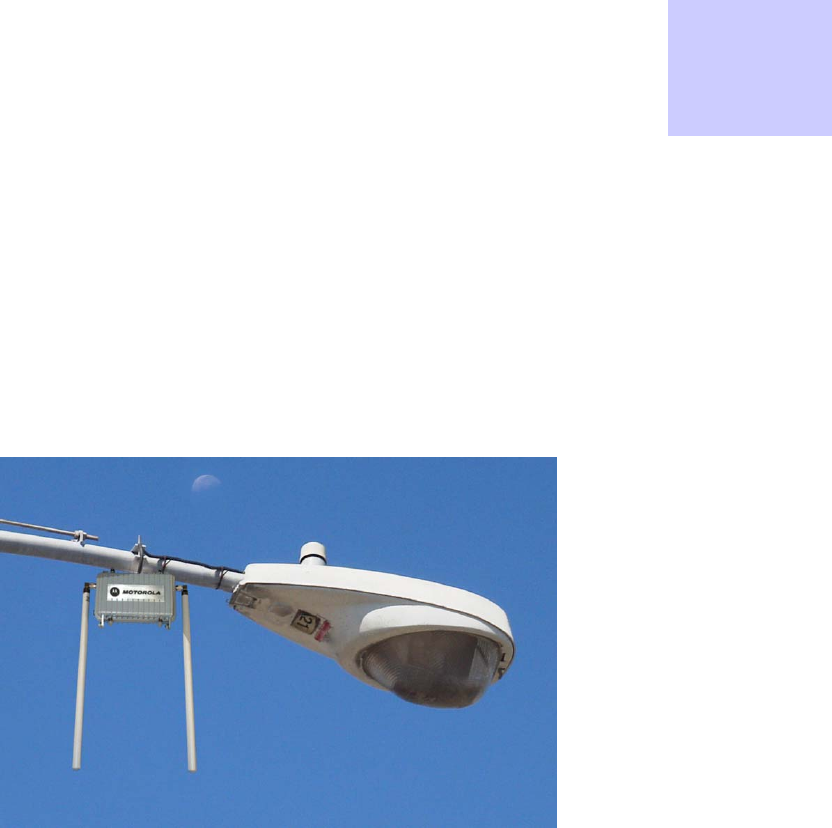
May 2007
1-1
Chapter
1
Chapter 1: Product Introduction
.............................................
.
.
.
.
This guide will provide you with technical specifications, installation guidelines, and testing
procedures for the MOTOMESH Duo 4300 infrastructure devices.
Figure 1-1 MWR4300 Device
Infrastructure Devices
The MOTOMESH DUO 4300 device is configured to run as an Intelligent Access Point (IAP) from
the factory. The device is capable of being customer-configured to run as either an IAP or a MWR
(Mesh Wireless Router). The selection of an IAP or a MWR configuration will be determined by the
customer’s wireless network needs at the time of purchase.
When the MOTOMESH Duo 4300 device is configured to run as an IAP, it acts as the transition point
from the wireless network to the wired core network and from there, through media gateways, out to
the Internet. When the MOTOMSH Duo 4330 device is configured to run as a MWR, it behaves as a
wireless device that is primarily deployed to seed and extend the range between IAPs and Wireless
Clients while simultaneously increasing the spectral efficiency of the network. While running as a
MWR device, the device’s Ethernet connector can be utilized to connect to another IP-enabled device.
This allows a network of IP-enabled devices (such as a camera) to be directly addressed, accessed and
managed over the MOTOMESH network.
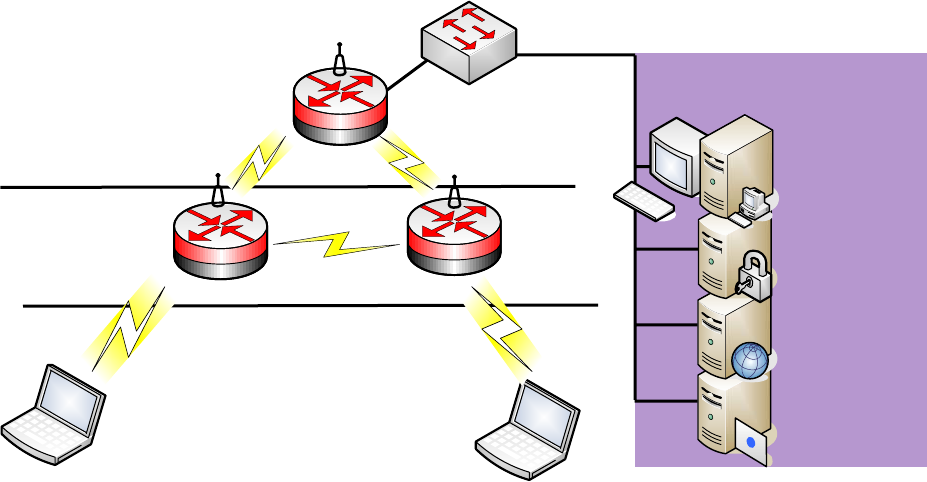
Chapter 1: Product Introduction
May 2007
1-2
IAP functionality includes:
• Transition Point between the wired and wireless network
• Dynamic Route Selection
MWR functionality includes:
• Dynamic Route Selection
• Range Extension for all other network devices
Infrastructure Devices within a MOTOMESH 2.0
Wireless Network
.............................................
.
.
A MOTOMESH Duo 4300 device is considered a fixed Infrastructure device that can be configured
to run as either an IAP (Intelligent Access Point) or a MWR (Mesh Wireless Router) within the
MOTOMESH Wireless Network. Infrastructure devices provide area coverage access for wireless
clients to the wired network.
Figure 1-2 MWR and IAP Devices in Context of a MOTOMESH Network
Wireless
802.11
802.11
802.11
802.11
EMS
CA
GEO
RADIUS
IAP
MWR MWR
802.11
Access Points
Wireless Routers
(MeshManager)
Wireless Switch
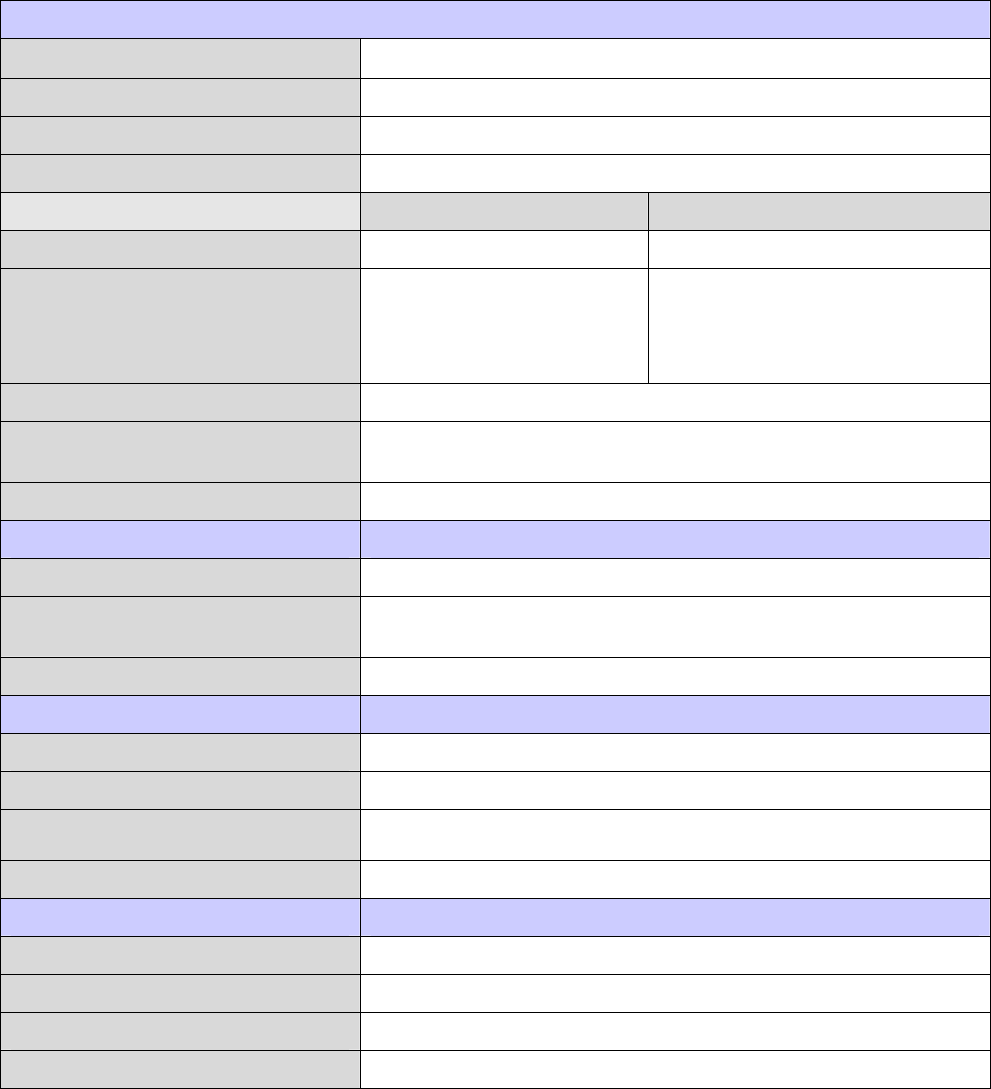
MOTOMESH DUO 4300 Users Guide
May 2007
1-3
MOTOMESH Duo 4300 Device Specifications
The following specification tables apply to the MOTOMESH Duo 4300-49, 4300-58, and 4300-54
Infrastructure Devices.
Table 1-1 MOTOMESH Duo 4300-49 Device Specifications
Radio Characteristics
Primary Radio Operating Freq. (GHz) 2.4 to 2.4835 (2nd ISM band)
Secondary Radio Operating Freq. (GHz) 4.94 to 4.99 (U-NII band)
Wi-Fi Support 802.11b/g at 2.4GHz; 802.11a at 4.9GHz
RF Modulation CCK / OFDM
2.4 GHz Portion 4.9 GHz Portion
Output Power (Maximum) 35 dBm EIRP 34 dBm EIRP
Receive Sensitivity 801.11b: -92 dBm (at 11 Mbps)
to -100 dBm (at 1 Mbps)
801.11g: -70 dBm (at 54 Mbps)
to -95 dBm (at 6 Mbps)
802.11a: -70 dBm (at 27 Mbps) to -93
dBm (at 3 Mbps)
Power Control 1dB increments
Antenna Type Two (2) omnidirectional, 8 dBi (for 2.4 GHz Radio) and 10 dBi (for 4.9
GHz Radio)
Antenna Connector N-Type
Routing
Routing Engine MeshConnex Layer 2 routing with Layer 1 situational-awareness
Routing Protocol Patented, hybrid proactive/reactive routing (low latency & fast route
convergence)
IEEE 802.11s Support Upgradeable to final IEEE 802.11s standard via OTA software updates
Network
Network Management Software MeshManager Element Management System via secure SNMP v.3
Network Interface 10/100Mbps Ethernet (RJ-45) port with surge suppression
Network Segmentation Multiple SSIDs with VLAN mapping
Quality of Service (QoS) 802.11e, EDCF, and IP precedence bits (ToS) supported via DSC
Security
Virtual LAN (VLAN) Supports up to sixteen (16) per node, or 4094 per network
Client Encryption Support WEP, WPA (TKIP) and WPA2 (AES, 802.11i)
Internodal Encryption Intra-Mesh Security
Authentication 802.1X (Infrastructure/Client) and MAC address hardware authentication
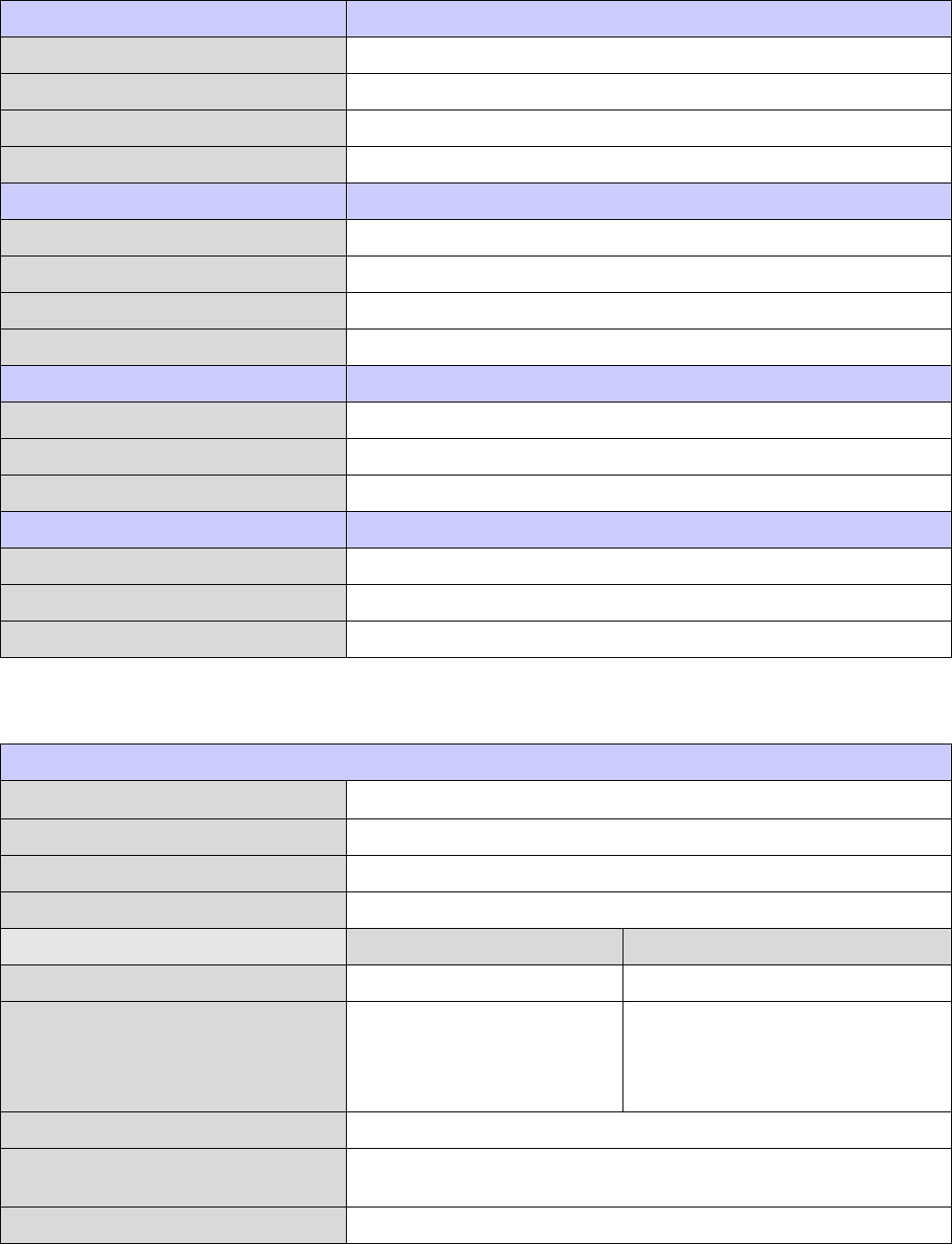
Chapter 1: Product Introduction
May 2007
1-4
Power
Power Requirements 90 -264 VAC (with variation at 47 to 63 Hz)
Power Connector AC power cord, 12 ft
Power Consumption 15W (with both radios operating at 50% duty cycle)
Power over Ethernet (PoE) Support for Canopy PoE connection
Physical
Dimensions 9”x 6”x 3.5” (23.1cm x 15.2cm x 8.9cm)
Weight 4.5 lbs (2.04kg)
Packaging Outdoor, all-weather enclosure (NEMA 4)
Mounting 3” (7.62cm) diameter post mounting
Environment
Temperature Range -30 to +60 °C
Humidity 0 to 95%, non-condensing
Certifications FCC Part 15 & 90, UL, CSA
Available Options
Mounting Lamp post mount bracket assembly
Power AC photo cell adapter
DC Input 12 VDC +- 2 VDC
Table 1-2 MOTOMESH Duo 4300-58 Device Specifications
Radio Characteristics
Primary Radio Operating Freq. (GHz) 2.4 to 2.4835 (2nd ISM band)
Secondary Radio Operating Freq. (GHz) 5.725 to 5.825 (UNI-3 band)
Wi-Fi Support 802.11b/g at 2.4GHz; 802.11a at 5.8GHz
RF Modulation CCK / OFDM
2.4 GHz Portion 5.8 GHz Portion
Output Power (Maximum) 35 dBm EIRP 34 dBm EIRP
Receive Sensitivity 801.11b: -92 dBm (at 11 Mbps)
to -100 dBm (at 1 Mbps)
801.11g: -70 dBm (at 54 Mbps)
to -95 dBm (at 6 Mbps)
802.11a: -70 dBm (at 54 Mbps) to -93
dBm (at 6 Mbps)
Power Control 1dB increments
Antenna Type Two (2) omnidirectional, 8 dBi (for 2.4 GHz Radio) and 10 dBi (for 5.8
GHz Radio)
Antenna Connector N-Type
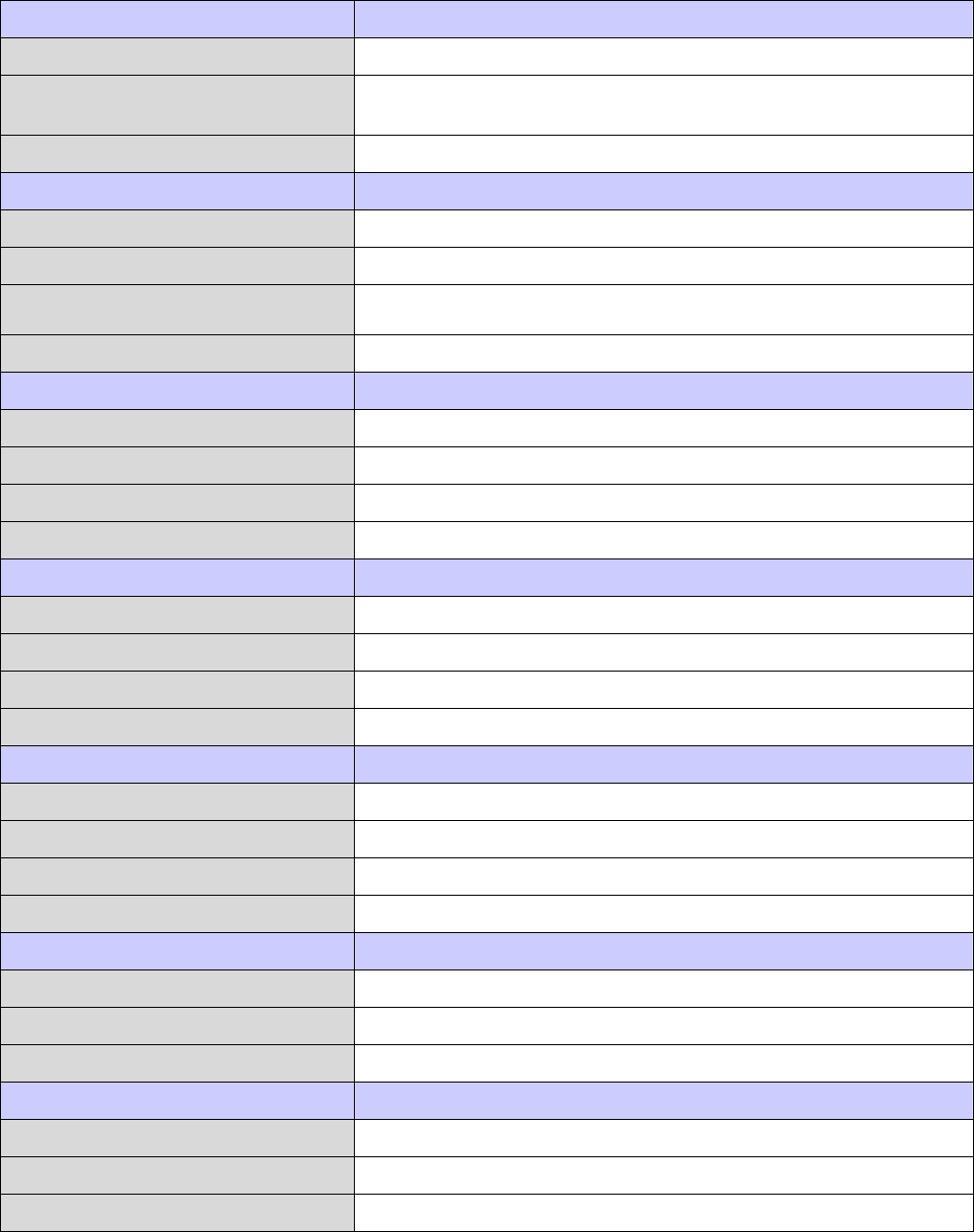
MOTOMESH DUO 4300 Users Guide
May 2007
1-5
Routing
Routing Engine MeshConnex Layer 2 routing with Layer 1 situational-awareness
Routing Protocol Patented, hybrid proactive/reactive routing (low latency & fast route
convergence)
IEEE 802.11s Support Upgradeable to final IEEE 802.11s standard via OTA software updates
Network
Network Management Software MeshManager Element Management System via secure SNMP v.3
Network Interface 10/100Mbps Ethernet (RJ-45) port with surge suppression
Network Segmentation Multiple SSIDs with VLAN mapping
Quality of Service (QoS) 802.11e, EDCF, and IP precedence bits (ToS) supported via DSC
Security
Virtual LAN (VLAN) Supports up to sixteen (16) per node, or 4094 per network
Client Encryption Support WEP, WPA (TKIP) and WPA2 (AES, 802.11i)
Internodal Encryption Intra-Mesh Security
Authentication 802.1X (Infrastructure/Client) and MAC address hardware authentication
Power
Power Requirements 90-264 VAC (with variation at 47 to 63 Hz)
Power Connector AC power cord, 12 ft
Power Consumption 15W (with both radios operating at 50% duty cycle)
Power over Ethernet (PoE) Support for Canopy PoE connection
Physical
Dimensions 9”x 6”x 3.5” (23.1cm x 15.2cm x 8.9cm)
Weight 4.5 lbs (2.04kg)
Packaging Outdoor, all-weather enclosure (NEMA 4)
Mounting 3" (7.62cm) diameter post mounting
Environment
Temperature Range -30 to +60 °C
Humidity 0 to 95%, non-condensing
Certifications FCC Part 15 & 90, UL, CSA
Available Options
Mounting Lamp post mount bracket assembly
Power AC photo cell adapter
DC Input 12 VDC +- 2 VDC
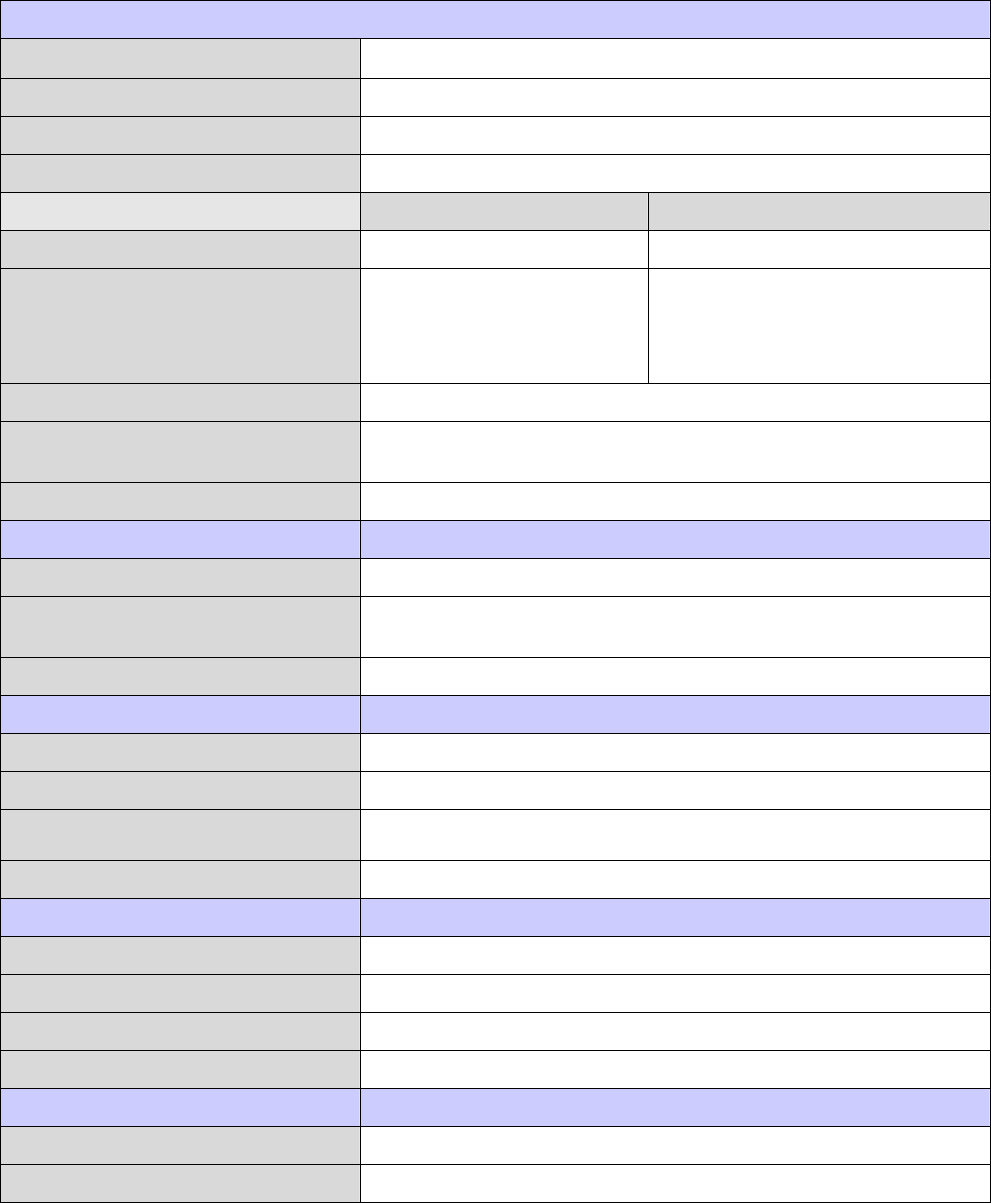
Chapter 1: Product Introduction
May 2007
1-6
Table 1-3 MOTOMESH Duo 4300-54 Device Specifications
Radio Characteristics
Primary Radio Operating Freq. (GHz) 2.4 to 2.4835 (2nd ISM band)
Secondary Radio Operating Freq. (GHz) 5.49 to 5.71 (ETSI – Band B)
Wi-Fi Support 802.11b/g at 2.4GHz; 802.11a at 5.4GHz
RF Modulation CCK / OFDM
2.4 GHz Portion 5.4 GHz Portion
Output Power (Maximum) 35 dBm EIRP 30 dBm EIRP
Receive Sensitivity 801.11b: -92 dBm (at 11 Mbps)
to -100 dBm (at 1 Mbps)
801.11g: -70 dBm (at 54 Mbps)
to -95 dBm (at 6 Mbps)
802.11a: -70 dBm (at 54 Mbps) to -93
dBm (at 6 Mbps)
Power Control 1dB increments
Antenna Type Two (2) omnidirectional, 8 dBi (for 2.4 GHz Radio) and 10 dBi (for 5.8
GHz Radio)
Antenna Connector N-Type
Routing
Routing Engine MeshConnex Layer 2 routing with Layer 1 situational-awareness
Routing Protocol Patented, hybrid proactive/reactive routing (low latency & fast route
convergence)
IEEE 802.11s Support Upgradeable to final IEEE 802.11s standard via OTA software updates
Network
Network Management Software MeshManager Element Management System via secure SNMP v.3
Network Interface 10/100Mbps Ethernet (RJ-45) port with surge suppression
Network Segmentation Multiple SSIDs with VLAN mapping
Quality of Service (QoS) 802.11e, EDCF, and IP precedence bits (ToS) supported via DSC
Security
Virtual LAN (VLAN) Supports up to sixteen (16) per node, or 4094 per network
Client Encryption Support WEP, WPA (TKIP) and WPA2 (AES, 802.11i)
Internodal Encryption Intra-Mesh Security
Authentication 802.1X (Infrastructure/Client) and MAC address hardware authentication
Power
Power Requirements 90-264 VAC (with variation at 47 to 63 Hz)
Power Connector AC power cord, 12 ft
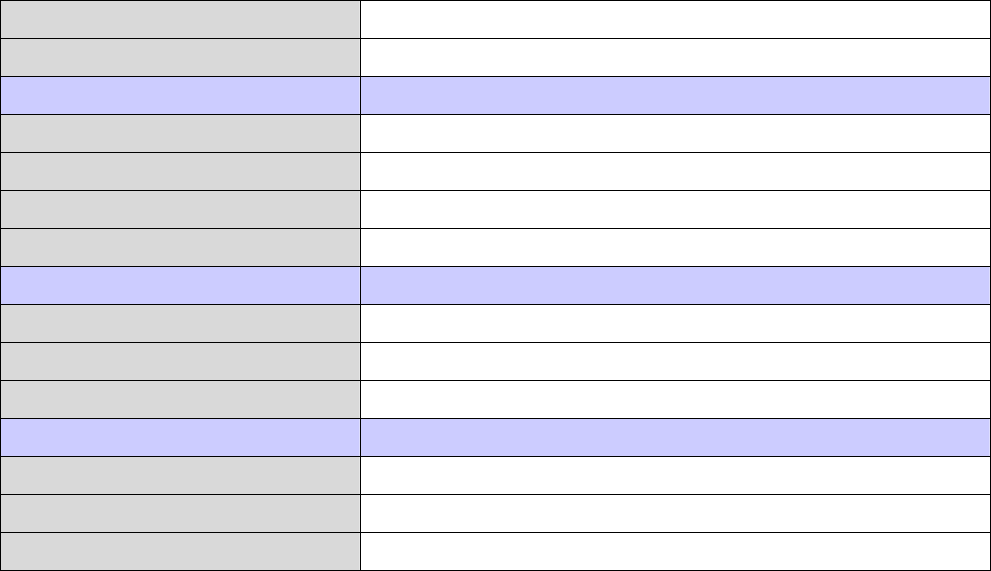
MOTOMESH DUO 4300 Users Guide
May 2007
1-7
Power Consumption 15W (with both radios operating at 50% duty cycle)
Power over Ethernet (PoE) Support for Canopy PoE connection
Physical
Dimensions 9”x 6”x 3.5” (23.1cm x 15.2cm x 8.9cm)
Weight 4.5 lbs (2.04kg)
Packaging Outdoor, all-weather enclosure (NEMA 4)
Mounting 3" (7.62cm) diameter post mounting
Environment
Temperature Range -30 to +60 °C
Humidity 0 to 95%, non-condensing
Certifications FCC Part 15 & 90, UL, CSA
Available Options
Mounting Lamp post mount bracket assembly
Power AC photo cell adapter
DC Input 12 VDC +- 2 VDC

May 2007
2-1
Chapter
2
Chapter 2: Infrastructure Device
Installation
.............................................
.
.
This chapter will provide hardware and software installation information for the MOTOMESH DUO
4300 Infrastructure Device.
Software Requirements
.............................................
.
.
The MOTOMESH DUO 4300 infrastructure devices must be setup and configured using the
MeshManager Element Management System.
The MeshManager Element Manager System is used for device setup, configuration, and management
of MOTOMESH infrastructure devices. Prior to using the MeshManager software for device
installation and configuration, ensure that it is installed and running on a network computer.
MeshManager will be used during the device setup process to validate the installation of the device(s)
as well as manage, within the wireless network.
Detailed information about the MeshManager application is found in the MeshManager Users Guide.
Hardware Installation Notes
.............................................
.
.
For a MOTOMESH 2.0 deployment, a permanent power source for each MOTOMESH Duo 4300
device must be provided. All infrastructure devices require professional installation to ensure that the
installation is performed in accordance with FCC licensing regulations
Infrastructure devices are fitted with two mounting brackets designed to be attached to light poles and
other probable installation sites. Alternate mounting hardware is available for mounting directly to
posts or structures that are too large for the standard brackets. Optional remote antenna mount
hardware is also available for use with the alternate mounting hardware.

Chapter 2: Infrastructure Device Installation
May 2007
2-2
Equipment Specification
The specifications listed in the following table apply for all Infrastructure devices.
Table 2-1 MOTOMESH Duo 4300-49 Radio Characteristics
Characteristic 2.4GHz
802.11 b/g
4.9GHz
Output Power 27 dBm 25 dBm
RF Modulation CCK/OFDM OFDM
Operating Frequency (GHz) 2.4 - 2.4835 4.94 - 4.99
EIRP 35 dBi 34 dBi
Channel Selection 20 MHz 10 - 20 MHz
Table 2-2 MOTOMESH Duo 4300-58 Radio Characteristics
Characteristic 2.4GHz
802.11 b/g
5.8GHz
802.11a
Output Power 27 dBm 25 dBm
RF Modulation CCK/OFDM OFDM
Operating Frequency (GHz) 2.4 - 2.4835 5.725 - 5.825
Maximum Burst Data Rate 54 Mbps 54 Mbps
Spectrum Used 20 MHz 20 MHz
Table 2-3 MOTOMESH Duo 4300-54 Radio Characteristics
Characteristic 2.4GHz
802.11 b/g
5.4GHz
Output Power 27 dBm 25 dBm
RF Modulation CCK/OFDM OFDM
Operating Frequency (GHz) 2.4 - 2.4835 5.49 - 5.71
Maximum Burst Data Rate 54 Mbps 54 Mbps
Spectrum Used 20 MHz 20 MHz
Ports and Connections
The following list defines the standard ports and connections for the MOTOMESH Duo 4300 device
running in either the IAP or MWR modes.
• Device Enclosure with 2 N-type Female Antenna Connector
MOTOMESH DUO 4300 Users Guide
May 2007
2-3
• 120V A/C Power Cable with flying leads
• One Ethernet port
• Canopy Connect PoE (IAP Devices only) or standards based 802.3af PoE (IAP and
MWR). NOTE: At this time, the IAPs can only be pre-configured to use Canopy
Connect PoE or Standards Based PoE (IAP and MWR), or none of the two PoEs, at the
time of purchase. These options are not available after the device has already been
configured and shipped to a customer site.
• Optional External Personality Plug to activate power over Ethernet (Motorola Canopy ™
PoE (on IAP Devices only) or standards based 802.3af PoE (on the IAP and MWR).
• Mounting Bracket (Standard and Optional)
Operator Supply List
The Network Operator must supply the following equipment:
• Mounting Location
• Power Source (120V A/C depending on IAP configuration)
• Ethernet connection between the IAP and MiSC.
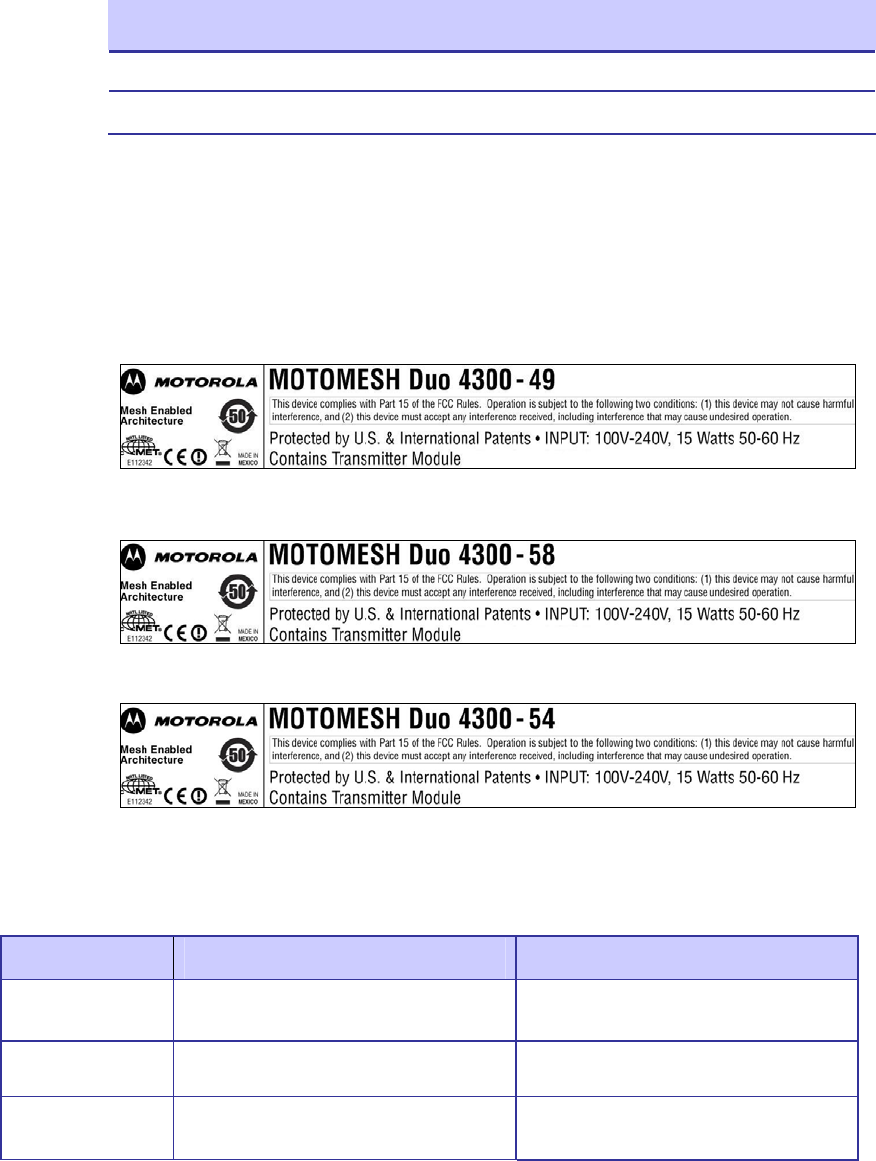
Chapter 2: Infrastructure Device Installation
May 2007
2-4
Optional Antennas
The following antennas are recommended for use with Infrastructure Devices.
Table 2-4 Recommended Antennas for Infrastructure Devices
Manufacturer Part Number Gain Usage
Maxrad MFB2408NMDC 8 dBi 2.4 GHz Infrastructure
Radiall-Larsen R380.700.212 10 dBi 5.8 GHz Infrastructure
MOTOMESH DUO Infrastructure Device Labels
The MAC address for each device is recorded on a label located on the device enclosure. Record this
number in the provided IAP or MWR MAC Address Table section. The MAC Addresses will be
required later to configure and test the device.
Figure 2-1 MOTOMESH DUO 4300 - 49 Device Product Label (sample)
Figure 2-2 MOTOMESH DUO 4300 - 58 Device Product Label (sample)
Figure 2-3 MOTOMESH DUO 4300 - 54 Device Product Label (European Use only)
Infrastructure Device MAC Address Table
Table 2-5 MAC Address Table
MWR or IAP Device Name Ethernet MAC IP Address
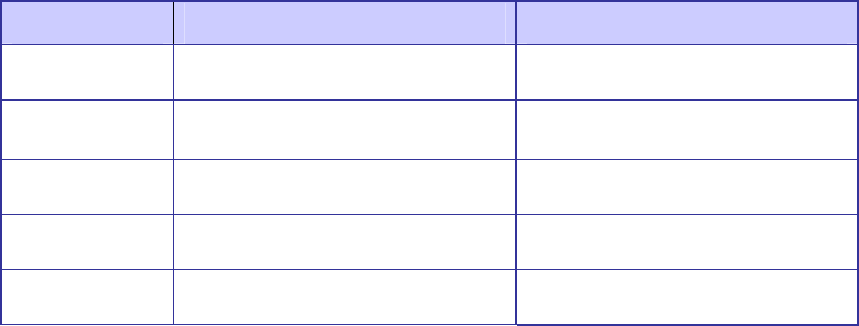
MOTOMESH DUO 4300 Users Guide
May 2007
2-5
MWR or IAP Device Name Ethernet MAC IP Address
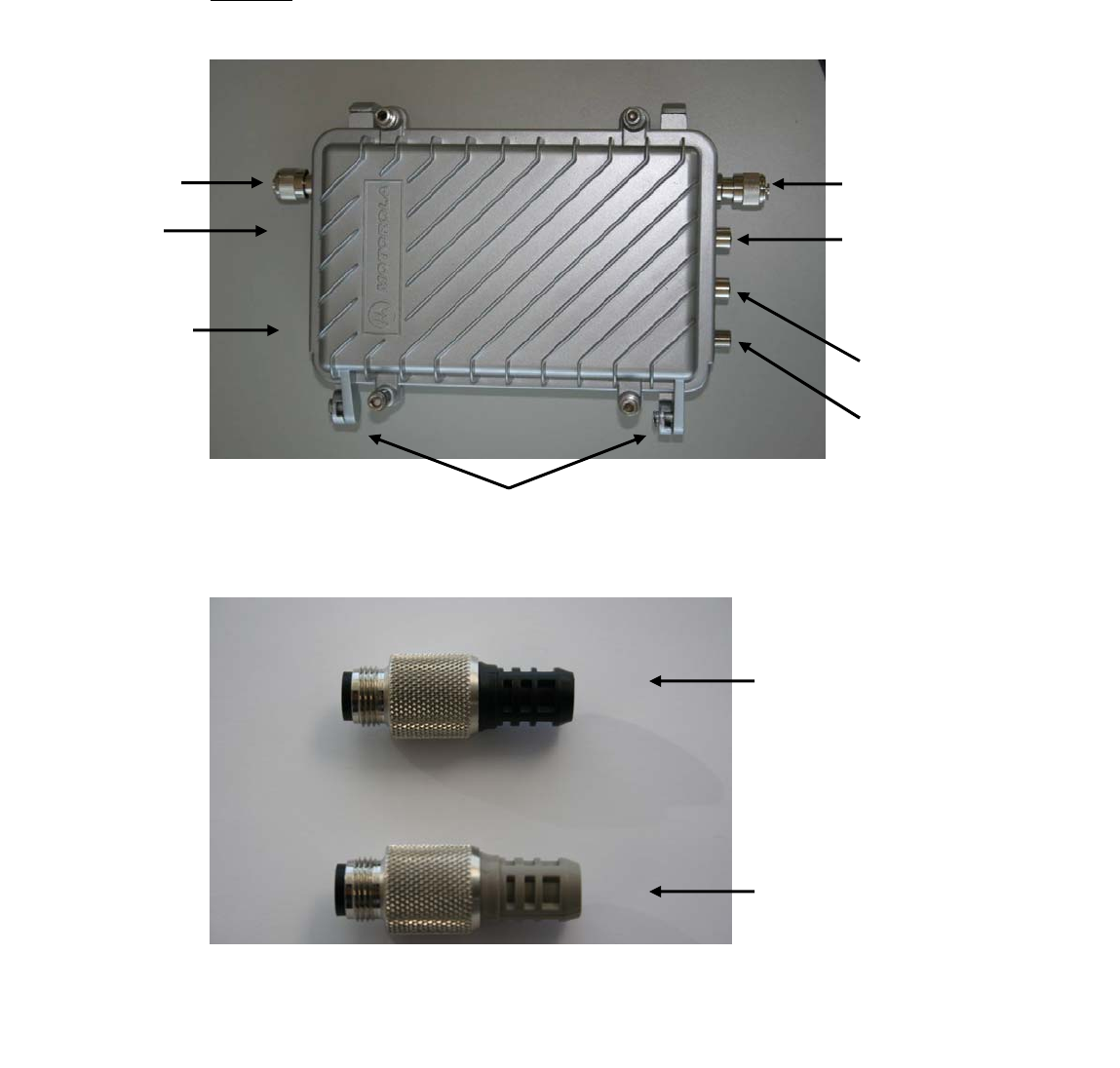
Chapter 2: Infrastructure Device Installation
May 2007
2-6
Infrastructure Device Assembly
Figure 2-4 shows the external connection points for a MOTOMESH Duo 4300 device.
Figure 2-4 Infrastructure Device Top View showing External Connection Points
Figure 2-5 External Personality Plugs (Use Black or Grey, or none)
N-Type Antenna (5.8)
Power
N-Type Antenna
(2.4)
Gore Vent
Device Hinges
Optional PoE feature port (must
be configured at time of
purchase). Standards based
802.3af POE (IAP and MWR) or
Canopy Connect PoE (IAP
only).
Ethernet Por
t
N-Type Antenna (5.8)
N-Type Antenna (4.9,
5.4, or 5.8)
Optional External
Personality Plug will
be placed here
ONLY if the
Standards based
802.3af PoE or
Canopy PoE (option)
is purchased. If
neither PoE is
purchased, the port
will be covered.
Black plug for use
with the Canopy PoE
option (IAP Devices
only).
Grey plug for use with
the Standards based
802.3af PoE option (IAP
and MWR Devices).
NOTE: If your device does not have either of the
plugs, it may mean that neither of the available PoE
Options was purchased.
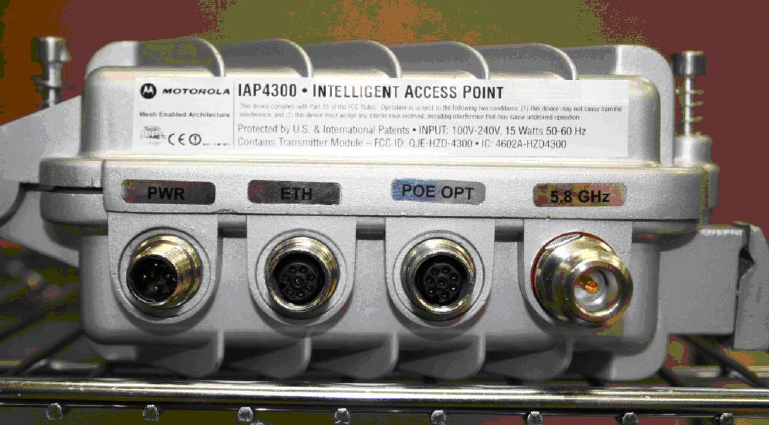
MOTOMESH DUO 4300 Users Guide
May 2007
2-7
Figure 2-6 Close Up of External Connection Points
Infrastructure Device Deployment and Installation
The MWR and the IAP devices require professional installation to ensure that the installation is
performed in accordance with FCC licensing regulations. All common precautions for grounding and
electrostatic discharge protection should be observed during deployment and installation.
Observe the following additional guidelines when deploying fixed Infrastructure devices (MWR and
IAP):
• The MOTOMESH Duo 4300 device may be mounted on a pole having a diameter of 1-
3.5 inches, utilizing the provided brackets.
• The antenna must have a separation distance of at least 2 meters from the body of all
persons and must not be co-located or operating in conjunction with any other antenna
or transmitter.
• Users and installers must be provided with antenna installation and transmitter operating
conditions to satisfy RF exposure compliance.
• When deploying the MOTOMESH Duo 4300 device, the antenna(s) should be a
minimum of 30 inches from any nearby metal poles to avoid distortion of the RF pattern.
• The installation location must provide power to the MOTOMESH DUO 4300 Device.
• It is the responsibility of the Network Operator to ensure that the installation complies
with any local building codes and permits.
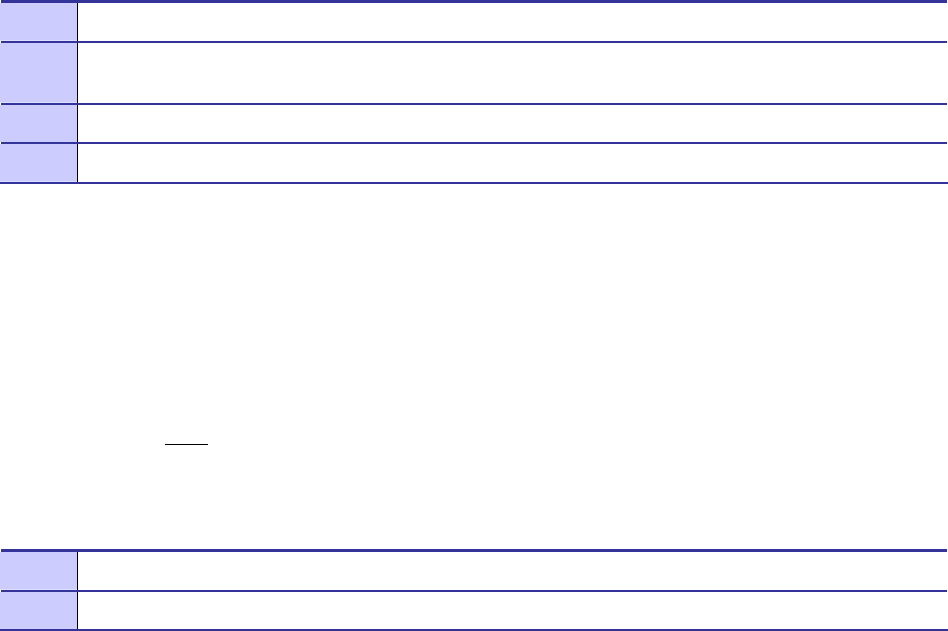
Chapter 2: Infrastructure Device Installation
May 2007
2-8
Grounding Considerations
In order for a grounding system to be effective, a low impedance path to earth ground must be present.
The grounding system must have conductors of sufficient size to withstand the high fault currents that
must be shunted along this path. The lower the impedance the grounding system displays, the better its
capability to perform its task. The impedance requirement for a communications site is determined by
the classification of the site. Sites are broken down into 2 categories: Type A-Light Duty and Type B-
Light Industrial/Commercial. Type A-Light Duty sites have impedance requirements of 25 ohms or
less to ground whereas Type B- Light Industrial/Commercial sites have impedance requirements of
less than 5 ohms to ground. MOTOMESH 2.0 networks fall into the Type B-Light
Industrial/Commercial category, and therefore must be treated with greater considerations as far as
grounding requirements are concerned.
Since Type B grounding requirements stipulate 5 ohms or less impedance to earth ground, things such
as soil pH, type of grounding rods, size of conductors, and ground enhancing materials must be taken
into account to achieve this goal. To verify the impedance requirements are met, a special
Earth/Ground Resistance Tester (megohmmeter) may be necessary.
• If the MOTOMESH 2.0 product is attached to a light arm and the attachment point
meets the Type B grounding requirements, then the grounding stud attachment point is
not required to be used.
Assembling the MOTOMESH Duo Device
Use the following procedure to assemble a MOTOMESH Duo Device.
Procedure 2-1 Assembling the MOTOMESH Duo Device
Initial Infrastructure Device Configuration Information
Prior to attempting the configuration of a MOTOMESH Duo device, ensure that the device is powered
up and has connectivity to the MiSC.
Device Connectivity Testing
Only after a MiSC has been setup on the network, and an infrastructure device has been added using
the MeshManager, element management system software, that the procedure below can be used to
verify connectivity to a device.
Procedure 2-2 Testing Infrastructure Device Connectivity
1 Place the brackets at the desired position on the pole.
2 Adjust the position of the box so that the antenna connecters are positioned vertically. Align the antennas
with the N-type connectors on the box and rotate to close.
3 Insert the cable into the external Ethernet port and tighten the connector to ensure a weatherproof seal.
4 Insert the Power Plug into the 4-pin connector.
1 Apply power to the device, the device should be operation in 60 to 120 seconds
2 Obtain the 802.11 MAC addresses for the device subcomponents that were recorded in the MAC Address

MOTOMESH DUO 4300 Users Guide
May 2007
2-9
Table earlier in this manual. The address will be in the following format: xx-xx-xx-xx-xx-xx.
3 Within MeshManager’s Device Manager screen, right-click on the appropriate MWR or IAP device in
the Device Tree and select the Ping Device option.
4 Check for a successful response to the Ping command in the Named Device results dialog box. A
successful response to the ping commands verifies connectivity to the device (MWR or IAP).
5 Repeat steps 1-4 for additional MWR or IAP devices.

May 2007
3-1
Chapter
3
Chapter 3: Device Configuration
.............................................
.
.
.
.
This chapter includes the following sections:
- Pre-staging a MOTOMESH Duo 4300 device in MeshManager
- Second IP stack in MOTOMESH Duo Devices
Pre-staging a MOTOMESH Duo 4300 Device in
MeshManager
.............................................
.
.
This information will be available the week of 5-14-07 and will be reviewed by Craig Perkins and
probably someone in the System Test group.
Second IP Stack Aids in Troubleshooting
.............................................
.
.
The second IP Stack feature is available in MOTOMESH 2.0 Duo 4300 devices and allows for a pre-
configured SSID and connectivity to a fixed IP. This feature can assist you with correcting and
diagnosing some cases of stranded units rather than having to roll a bucket truck. Operators will find
this feature helpful when configuring nodes for expansion or replacement.
Second IP Stack Settings
A MOTOMESH Duo device can be accessed via a client access card (a PCMCIA Wireless Client
Card) that is attached to a laptop computer. The client access card must be set to the settings specified
in MeshManager for Device Recovery.
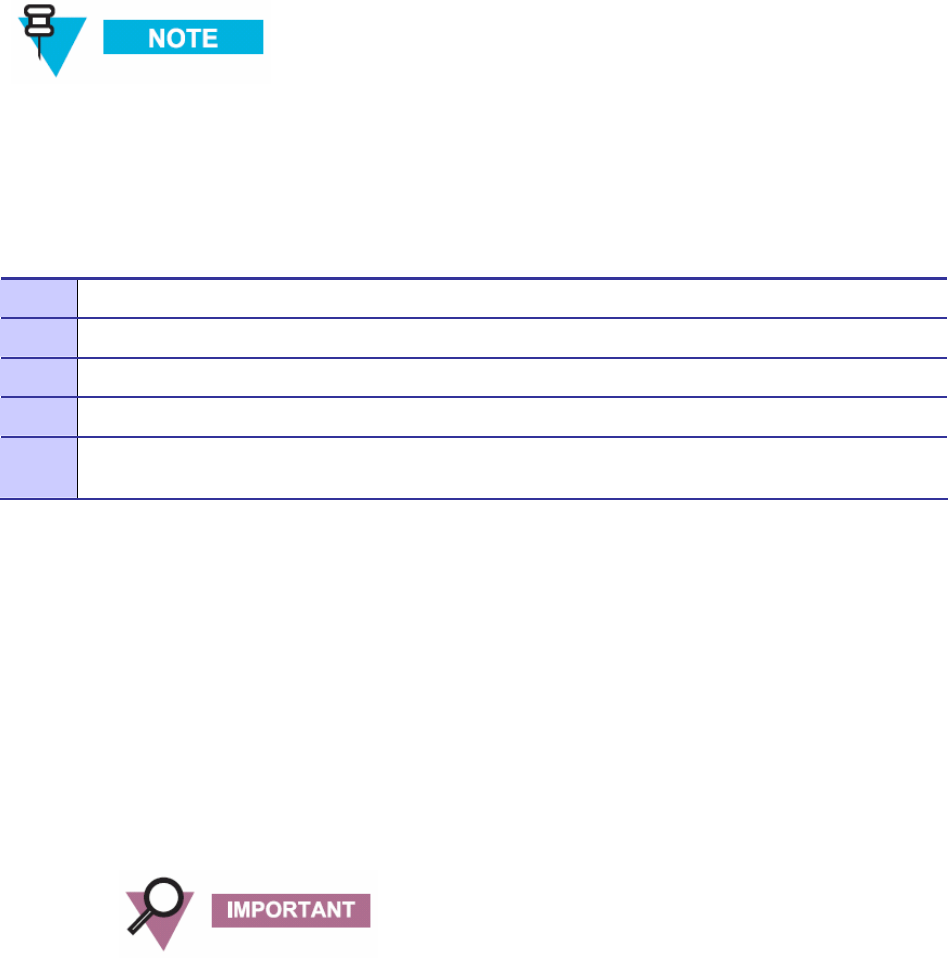
Chapter 3: Device Configuration
May 2007
3-2
NOTE: It is important to note that VAP 15 is to be used only for Second IP Stack data.
Accessing the MOTOMESH Duo Device Recovery Settings in
MeshManager
Procedure 3-1 Accessing the MOTOMESH Duo Device Recovery Settings
1 Select a specific device from the Device Tree in MeshManager.
2 From the right side of the screen, select Global Configuration from the Action drop-down list.
3 Select the Device Recovery tab.
4 View the Default VAP 15 Settings setup for the purpose of device recovery.
5 You can choose to keep the default settings or change them after your wireless network is setup,
configured, and working correctly.
Device Recovery Settings
The MOTOMESH Duo device recovery default settings (VAP 15) have the following conditions:
Authentication Type– WPA-AUTO-PSK
Cipher Mode- AUTO
Passphrase- blackd0g
Static IP Address- 192.168.1.1
IP network mask- 255.255.255.0
SSID- MotoMesh
SSID Suppression- On
If you change any of the default settings for VAP15, make sure that when it is time
to recover your MOTOMESH Duo Device that the Client Access Card is set to
match your current network settings for Device Recovery (VAP15).

May 2007
4-1
Chapter
4
Chapter 4: License Information
.............................................
.
.
.
.
This chapter includes the contents of the Motorola End User License Agreement (EULA) as well as a
Third Party License section.
Motorola End User License Agreement
.............................................
.
.
MOTOROLA, INC.
END USER LICENSE AGREEMENT
Motorola is willing to license its Mesh Networking Software Solutions (defined as “Products”
below) and the accompanying documentation to you only on the condition that you accept all the
terms in this License Agreement (“Agreement”).
IMPORTANT: READ THE FOLLOWING TERMS AND CONDITIONS BEFORE USING
THE ACCOMPANYING PRODUCTS.
BY CLICKING ON THE “ACCEPT” BUTTON BELOW, YOU ACKNOWLEDGE
THAT YOU HAVE READ THIS AGREEMENT, UNDERSTAND IT AND AGREE TO
BE BOUND BY THE TERMS OF THIS AGREEMENT. IF YOU DO NOT AGREE TO
THE TERMS OF THIS AGREEMENT, MOTOROLA IS NOT WILLING TO LICENSE
THE PRODUCTS TO YOU. YOU SHOULD CLICK ON THE “DO NOT ACCEPT”
BUTTON TO DISCONTINUE THE SOFTWARE INSTALLATION PROCESS. IF YOU
DO NOT AGREE TO THESE TERMS, YOU MAY, WITHIN FIFTEEN (15) DAYS,
RETURN THIS ENTIRE PRODUCT TO THE LOCATION WHERE YOU ACQUIRED
IT OR PROVIDE WRITTEN VERIFICATION OF DELETION OF ALL COPIES OF
THE ENTIRE PRODUCT IF YOU HAVE NOT PHYSICALLY RECEIVED A
PRODUCT FOR A FULL REFUND.
Chapter 4: License Information
May 2007
4-2
1. DEFINITIONS. In this Agreement, the word “Software” refers to the set of
instructions for computers, in executable form and in any media, (which may include
diskette, CD-ROM, downloadable internet, hardware, or firmware) licensed to you. The
word “Documentation” refers to electronic or printed manuals and accompanying
instructional aids licensed to you. The word “Product(s)” refers to the specific combination
of Software and Documentation that you have licensed and which has been provided to you
under the terms of this Agreement.
2. GRANT OF LICENSE. Motorola, Inc. (“Motorola”) grants you (“Licensee” or
“you”) a personal, nonexclusive, nontransferable license to use the Products subject to the
Conditions Of Use set forth in Section 3 below and the terms and conditions of this
Agreement. Any terms or conditions appearing on the face or reverse side of any purchase
order, purchase order acknowledgment or other order document that are different from,
or in addition to, the terms of this Agreement will not be binding on the parties, even if
payment is accepted.
3. CONDITIONS OF USE. Any use of the Products outside of the conditions set forth
herein is strictly prohibited and will be deemed a breach of this Agreement.
3.1 Only your employees or agents may use the Products. You shall take all necessary
steps to insure that your employees and agents abide by the terms of this Agreement.
3.2 You shall use the Products (i) only for your internal business purposes; (ii) only as
described in the Products; and (iii) in strict accordance with this Agreement.
3.3 Licensee may install and use the Products on a single client workstation, provided
that the use is in conformance with the terms set forth in this Agreement. The Products
may not be transferred to another party without the express written consent of Motorola,
regardless of whether or not such transfer is accomplished by physical or electronic means.
3.4. Portions of the Products are protected by United States copyright laws,
international treaty provisions, and other applicable laws. Therefore, you must treat the
Products like any other copyrighted material (e.g., a book or musical recording) except that
you may either: (a) make one (1) copy of the transportable part of the Products (which
typically is supplied on diskette, CD-ROM, or downloadable internet), solely for back-up
purposes; or (b) copy the transportable part of the Products to a PC hard disk, provided
you keep the original solely for back-up purposes. If the Documentation is in printed form,
it may not be copied. If the Documentation is in electronic form, you may print out one (1)
copy, which then may not be copied. With regard to the copy made for backup or archival
purposes, you agree to reproduce any Motorola copyright notice, and other proprietary
legends appearing thereon. Such copyright notice(s) may appear in any of several forms,
MOTOMESH DUO 4300 Users Guide
May 2007
4-3
including machine-readable form, and you agree to reproduce such notice in each form in
which it appears, to the extent it is physically possible to do so. Unauthorized duplication
of the Software or Documentation constitutes copyright infringement and in the United
States is punishable in federal court by fine and imprisonment.
3.5 You shall not export, re-export, resell, ship or divert or cause to be exported, re-
exported, resold, shipped or diverted, directly or indirectly, the Products under this
Agreement.
4. TITLE; RESTRICTIONS. If you transfer possession of any copy of the Products to
another party outside of the terms of this agreement, your license is automatically
terminated. Title and copyrights to the Products and any copies made by you remain with
Motorola and its licensors. You shall not, and shall not permit others to: (1) modify,
translate, decompile, bootleg, reverse engineer, disassemble, or extract the inner workings
of the Software or Documentation, (2) copy the look-and-feel or functionality of the
Software or Documentation; (3) remove any proprietary notices, marks, labels, or logos
from the Software or Documentation; (4) rent or transfer all or some of the Software or
Documentation to any other party without Motorola’s prior written consent; or (5) utilize
any computer software or hardware which is designed to defeat any copy protection device,
should the Products be equipped with such a protection device. If the Products contain
Software or Documentation that is provided on multiple types of media (such as diskette,
CD-ROM, downloadable internet), then you shall only use the medium which best meets
your specific needs, and shall not loan, rent, lease, or transfer the other media contained in
the package without Motorola’s written consent. Unauthorized copying of the Software or
Documentation, or failure to comply with any of the provisions of this Agreement, will
result in automatic termination of this license.
5. CONFIDENTIALITY. You acknowledge that all Products contain valuable
proprietary information and trade secrets and that unauthorized or improper use of the
Products will result in irreparable harm to Motorola for which monetary damages would
be inadequate and for which Motorola will be entitled to immediate injunctive relief.
Accordingly, you will limit access to the Products to those of your employees and agents
who need to use the Products for your internal business purposes, and you will take
appropriate action with those employees and agents to preserve the confidentiality of the
Products, using the same degree of care to avoid unauthorized or improper disclosure as
you use for the protection of your own proprietary software, but in no event less than
reasonable care.
Notwithstanding anything to the contrary herein, you shall have no obligation to preserve
the confidentiality of any proprietary information that: (i) was in the public domain at the
time of disclosure; (ii) entered the public domain through no fault of yours; (iii) was given
to you free of any obligation to keep it confidential; (iv) is independently developed by you;
or (v) is disclosed as required by law provided that you notify Motorola prior to such
disclosure and provide Motorola with a reasonable opportunity to respond.
Chapter 4: License Information
May 2007
4-4
6. RIGHT TO USE MOTOROLA’S NAME. Except as required in Section 3.4 above,
you shall not, during the term of this Agreement or thereafter, use any trademark, of
Motorola, or any word or symbol likely to be confused with any Motorola trademark,
either alone or in any combination with another word or words.
7. PAYMENT. The rights granted hereunder are contingent upon payment for the
Products. All payments shall be due net thirty (30) days from date of the invoice.
8. UPGRADES AND UPDATES. If the Products are licensed to you as an upgrade or
update to a product previously licensed to you, you must destroy the Products previously
licensed to you, including any copies, within thirty (30) days of your receipt of the update
or upgrade.
9. MAINTENANCE. Motorola shall not be responsible for maintenance or field
service of the Software under this Agreement.
10. LIMITED WARRANTY. All diskettes or CD-ROMS on which the Products are
furnished (“Media”) are warranted to be free from manufacturing and material defects for
ninety (90) days after the shipment date of the Products to you. Media that become
defective during such period shall be repaired or, at Motorola’s option, replaced. This
limited warranty is contingent upon proper use of the Media and does not cover Products
which have been tampered with, modified, or subjected to unusual physical or electrical
stress. Tampering with or removal of any factory seal or label on any Media voids this
warranty and releases Motorola from any and all liability.
11. DISCLAIMER. EXCEPT FOR THE ABOVE EXPRESS LIMITED
WARRANTIES, MOTOROLA MAKES, AND YOU RECEIVE, NO OTHER
WARRANTIES OF ANY KIND, WHETHER EXPRESS, IMPLIED, STATUTORY, OR
IN ANY COMMUNICATION WITH YOU. MOTOROLA SPECIFICALLY DISCLAIMS
ANY OTHER WARRANTY INCLUDING THE IMPLIED WARRANTIES OF
MERCHANTABILTY, NONINFRINGEMENT, OR FITNESS FOR A PARTICULAR
PURPOSE. THE PRODUCTS ARE PROVIDED “AS IS.” MOTOROLA DOES NOT
WARRANT THAT THE OPERATION OF THE SOFTWARE WILL BE
UNINTERRUPTED OR ERROR FREE OR THAT DEFECTS IN THE SOFTWARE
WILL BE CORRECTED. MOTOROLA MAKES NO WARRANTY WITH RESPECT
TO THE CORRECTNESS, ACCURACY, OR RELIABILITY OF THE SOFTWARE
AND DOCUMENTATION. Some jurisdictions do not allow the exclusion of implied
warranties, so the above exclusion may not apply to you.
12. REMEDIES. The entire liability of Motorola, and your exclusive remedy under the
warranty provided herein will be, at Motorola’s option, to repair or replace any Media
MOTOMESH DUO 4300 Users Guide
May 2007
4-5
found to be defective within the warranty period, or to refund the purchase price and
terminate this Agreement. To seek such a remedy, you must return the entire Product to
Motorola, with a copy of the original purchase receipt within the warranty period.
13. LIMITATION OF LIABILITY. THE TOTAL LIABILITY OF MOTOROLA
UNDER THIS AGREEMENT FOR DAMAGES SHALL NOT EXCEED THE TOTAL
AMOUNT PAID BY YOU FOR THE PRODUCTS LICENSED UNDER THIS
AGREEMENT. IN NO EVENT WILL MOTOROLA BE LIABLE IN ANY WAY FOR
INCIDENTAL, CONSEQUENTIAL, INDIRECT, SPECIAL OR PUNITIVE DAMAGES
OF ANY NATURE, INCLUDING WITHOUT LIMITATION, LOST BUSINESS
PROFITS, OR LIABILITY OR INJURY TO THIRD PERSONS, WHETHER
FORESEEABLE OR NOT, REGARDLESS OF WHETHER MOTOROLA HAS BEEN
ADVISED OF THE POSSIBLITY OF SUCH DAMAGES. Some jurisdictions do not
permit limitations of liability for incidental or consequential damages, so the above
exclusions may not apply to you.
14. U.S. GOVERNMENT. If you are acquiring the Products on behalf of any unit or
agency of the U.S. Government, the following shall apply. Use, duplication or disclosure of
the Products is subject to the restrictions set forth in subparagraphs (c)(1) and (2) of the
Commercial Computer Software-Restricted Rights clause at FAR 52.227-19 (JUNE 1987),
if applicable, unless being provided to the Department of Defense. If being provided to the
Department of Defense, use, duplication, or disclosure of the Products is subject to the
restricted rights set forth in subparagraph (c)(1)(ii) of the Rights in Technical Data and
Computer Software clause at DFARS 252.227-7013 (OCT 1988), if applicable. Software
and Documentation may or may not include a Restricted Rights notice, or other notice
referring specifically to the terms and conditions of this Agreement. The terms and
conditions of this Agreement shall each continue to apply, but only to the extent that such
terms and conditions are not inconsistent with the rights provided to you under the
aforementioned provisions of the FAR or DFARS, as applicable to the particular procuring
agency and procurement transaction."
15. TERM OF LICENSE. Your right to use the Products will begin when you click the
“ACCEPT” button below, which constitutes acceptance of the terms and conditions herein,
and will continue in perpetuity unless terminated as follows. Your right to use the
Products will terminate immediately without notice upon a breach of this Agreement by
you. Otherwise, this Agreement may be terminated by either party upon thirty (30) days
prior written notice. Within thirty (30) days after termination of this Agreement, you will
certify to Motorola in writing that through your best efforts, and to the best of your
knowledge, the original and all copies, in whole or in part, in any form, of the Software and
all related material and Documentation, have been destroyed, except that, with prior
written consent from Motorola, you may retain one copy for archival or backup purposes.
You may not sublicense, assign or transfer the license or the Products, except as expressly
provided in this Agreement. Any attempt to otherwise sublicense, assign or transfer any of
the rights, duties or obligations hereunder is null and void.
Chapter 4: License Information
May 2007
4-6
16. GOVERNING LAW. This Agreement shall be governed by the laws of the United
States of America to the extent that they apply and otherwise by the laws of the State of
Illinois.
17. ASSIGNMENT. This Agreement may not be assigned or otherwise transferred by
you.
18. SURVIVAL OF PROVISIONS. The parties agree that where the context of any
provision indicates an intent that it shall survive the term of this Agreement, then it shall
survive.
19. ENTIRE AGREEMENT. This Agreement contains the parties’ entire agreement
regarding your use of the Products and may be amended only in writing signed by both
parties, except that Motorola may modify this Agreement as necessary to comply with
applicable laws and regulations including FCC regulations.
20. THIRD PARTY SOFTWARE. The Software may contain one or more items of
Third-Party Software supplied by other third-party suppliers. The terms of this
Agreement govern your use of any Third-Party Software UNLESS A SEPARATE THIRD-
PARTY SOFTWARE LICENSE IS INCLUDED, IN WHICH CASE YOUR USE OF THE
THIRD-PARTY SOFTWARE WILL THEN BE GOVERNED BY THE SEPARATE
THIRD-PARTY LICENSE.
IF THE FOREGOING TERMS AND CONDITIONS ARE ACCEPTABLE TO YOU,
PLEASE INDICATE YOUR AGREEMENT AND ACCEPTANCE BY CLICKING
BELOW ON THE BUTTON LABELED “ACCEPT”.
IF THE FOREGOING TERMS AND CONDITIONS ARE NOT ACCEPTABLE TO
YOU, PLEASE CLICK ON THE “DO NOT ACCEPT” BUTTON BELOW.
MOTOROLA and the Stylized M logo are registered in the US Patent & Trademark
Office.
MOTOMESH DUO 4300 Users Guide
May 2007
4-7
Third Party Licensing Agreements
.............................................
.
.
The following section lists the respective copyright owners and the associated license information for
portions of Open Source code that may be included in Motorola’s MOTOMESH 2.0 Product line.
Hostapd - Copyright and License Information
hostapd - user space IEEE 802.11 AP and IEEE 802.1X/WPA/WPA2/EAP
Authenticator and RADIUS authentication server
================================================================
Copyright (c) 2002-2006, Jouni Malinen <jkmaline@cc.hut.fi> and
contributors
All Rights Reserved.
This program is dual-licensed under both the GPL version 2 and BSD
license. Either license may be used at your option.
License
-------
GPL v2:
This program is free software; you can redistribute it and/or modify
it under the terms of the GNU General Public License version 2 as
published by the Free Software Foundation.
This program is distributed in the hope that it will be useful,
but WITHOUT ANY WARRANTY; without even the implied warranty of
MERCHANTABILITY or FITNESS FOR A PARTICULAR PURPOSE. See the
GNU General Public License for more details.
You should have received a copy of the GNU General Public License
along with this program; if not, write to the Free Software
Foundation, Inc., 59 Temple Place, Suite 330, Boston, MA 02111-1307 USA
(this copy of the license is in COPYING file)
Alternatively, this software may be distributed under the terms of BSD
license:
Redistribution and use in source and binary forms, with or without
modification, are permitted provided that the following conditions are
met:
1. Redistributions of source code must retain the above copyright
Chapter 4: License Information
May 2007
4-8
notice, this list of conditions and the following disclaimer.
2. Redistributions in binary form must reproduce the above copyright
notice, this list of conditions and the following disclaimer in the
documentation and/or other materials provided with the distribution.
3. Neither the name(s) of the above-listed copyright holder(s) nor the
names of its contributors may be used to endorse or promote products
derived from this software without specific prior written permission.
THIS SOFTWARE IS PROVIDED BY THE COPYRIGHT HOLDERS AND CONTRIBUTORS
"AS IS" AND ANY EXPRESS OR IMPLIED WARRANTIES, INCLUDING, BUT NOT
LIMITED TO, THE IMPLIED WARRANTIES OF MERCHANTABILITY AND FITNESS FOR
A PARTICULAR PURPOSE ARE DISCLAIMED. IN NO EVENT SHALL THE COPYRIGHT
OWNER OR CONTRIBUTORS BE LIABLE FOR ANY DIRECT, INDIRECT, INCIDENTAL,
SPECIAL, EXEMPLARY, OR CONSEQUENTIAL DAMAGES (INCLUDING, BUT NOT
LIMITED TO, PROCUREMENT OF SUBSTITUTE GOODS OR SERVICES; LOSS OF USE,
DATA, OR PROFITS; OR BUSINESS INTERRUPTION) HOWEVER CAUSED AND ON ANY
THEORY OF LIABILITY, WHETHER IN CONTRACT, STRICT LIABILITY, OR TORT
(INCLUDING NEGLIGENCE OR OTHERWISE) ARISING IN ANY WAY OUT OF THE USE
OF THIS SOFTWARE, EVEN IF ADVISED OF THE POSSIBILITY OF SUCH DAMAGE.

May 2007
5-1
Chapter
5
Chapter 5: Customer Service
.............................................
.
.
.
.
This chapter provides information about how to obtain customer service support from Motorola and
describes the type of information you should have available prior to making the support call.
Customer Service Information
.............................................
.
.
If you have read this document and made every effort to resolve installation or operation issues
yourself and still require help, please contact Motorola System Support Center (SSC) using the
following contact information:
Hours of Operation
7 days a week, 24 hours
Technical Support: 800-221-7144 (USA)
Obtaining Support
Motorola provides technical support services for your system and recommends that you coordinate
warranty and repair activities through the Motorola System Support Center (SSC). When you consult
the Motorola SSC, you increase the likelihood that problems are rectified in a timely fashion and that
warranty requirements are satisfied. Check your contract for specific warranty and service information.
System Information
To be provided with the best possible opportunity for support, collect the following system information
and have it available when obtaining support.
• Location of the system
• Date the system was put into service
• Software or firmware version information for components of your system
Chapter 5: Customer Service
May 2007
5-2
• Serial number(s) of the device(s) or component(s) requiring support
• A written description of the symptom or observation of the problem:
- When did it first appear?
- Can it be reproduced?
- What is the step-by-step procedure to cause it?
• Do other circumstances contribute to the problem? For example, changes in weather or
other conditions?
• Maintenance action preceding problem:
- Upgrade of software or equipment
- Change in the hardware or software configuration
- Software reload - from backup or from CD-ROM (note the version and date)
Return Material Request
After collecting system information, contact the Motorola System Support Center for assistance or to
obtain a Return Material Authorization (RMA) number for faulty Field Replaceable Entities (FREs):
North America: 800-221-7144
Radio Products and Services Division
The Radio Products and Services Division is your source for manuals and replacement parts.
Radio Products and Services Division Telephone Numbers
The telephone numbers for ordering are: (800)-422-4210 (US and Canada orders)
The fax numbers are: (800)-622–6210 (US and Canada orders)
The number for help identifying an item or part number is (800)-422-4210; select choice “3” from the
menu
Returning System Components to Motorola
Motorola's service philosophy is based on field replaceable entities (FREs). FREs are system
components identified by Motorola to be returned to Motorola for repair.
Returning FREs
Return faulty FREs to Motorola for repair. When you return an assembly for service, follow these best
practices:
• Place any assembly containing CMOS devices in a static-proof bag or container for
shipment.
• Obtain a return authorization (RA) number from the Motorola System Support Center.
MOTOMESH DUO 4300 Users Guide
May 2007
5-3
• Include the warranty, model, kit numbers, and serial numbers on the job ticket, as
necessary.
• If the warranty is out of date, you must have a purchase order.
• Print the return address clearly, in block letters.
• Provide a phone number where your repair technician can be reached.
• Include the contact person's name for return.
• Pack the assembly tightly and securely, preferably in its original shipping container.
Chapter 5: Customer Service
May 2007
5-4
This page intentionally left blank.

May 2007
6-1
Chapter
6
Chapter 6: Certification and Safety
Information
.............................................
.
.
.
.
This chapter lists the relevant FCC Certification and Product Safety Information for the MOTOMESH
devices described in this manual.
FCC Regulatory Information
This device complies with Part 15 of the FCC Rules. Operation is subject to the following two
conditions: (1) this device may not cause harmful interference, and (2) this device must accept any
interference received; including interference that may cause undesired operation.
The MWR4300 requires professional installation to ensure the installation is performed in accordance
with FCC licensing regulations.
Federal Communications Commission (FCC) Statement:
This equipment has been tested and found to comply with the limits for a Class A digital device,
pursuant to part 15 of the FCC Rules. These limits are designed to provide reasonable protection
against harmful interference when the equipment is operated in a commercial environment. This
equipment generates, uses, and can radiate radio frequency energy and, if not installed and used in
accordance with the instruction manual, may cause harmful interference to radio communications.
Operation of this equipment in a residential area is likely to cause harmful interference in which case
the user will be required to correct the interference at his own expense.
Any changes or modifications not expressly approved by Motorola could void the user’s authority to
operate the equipment.
FCC RF Radiation Exposure Statement
This equipment complies with FCC radiation exposure limits set forth for an uncontrolled
environment. This equipment should be installed and operated with minimum distance 2 meters
between the radiator and your body.
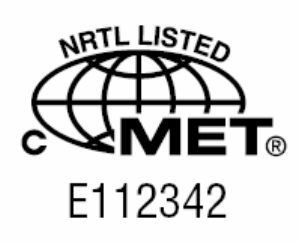
Chapter 6: Certification and Safety Information
May 2007
6-2
Safety Information for MOTOMESH Products
The Federal Communications Commission (FCC) with its action in ET Docket 96-8 has adopted a
safety standard for human exposure to radio frequency (RF) electromagnetic energy emitted by FCC
certified equipment. Motorola MOTOMESH products meet the uncontrolled environmental limits
found in OET-65 and ANSI C95.1, 1991. Proper operation of this radio according to the instructions
found in this manual and the hardware and software guides on the MOTOMESH CD will result in user
exposure that is substantially below the FCC recommended limits.
• Do not touch or move the antenna(s) while the unit is transmitting or receiving.
• Do not hold any component containing a radio such that the antenna is very close to or
touching any exposed parts of the body, especially the face or eyes, while transmitting.
• Do not operate a portable transmitter near unshielded blasting caps or in an explosive
environment unless it is a type especially qualified for such use.
• Do not operate the radio or attempt to transmit data unless the antenna is connected;
otherwise, the radio may be damaged.
Safety Certification
Conforms to UL STD ANSI/UL 60950 3rd Edition
Certified to CAN/CSA C22.2 NO. 60950-00
Equipment shall be suitable for use in Air pressure: 86kPa to106kPa.

May 2007
Index -1
Index
Index
.............................................
.
.
.
.
A
Alternate mounting hardware, 2-1
antenna, 2-1, 2-7, 2-8, 6-2
C
Connectivity Testing, 2-8
Copyrights, iii
D
Device Label, 2-4
Device Specifications, 1-3, 1-4, 1-6
Disclaimer, iii
E
Equipment Specification, 2-2
external connection points, 2-6
F
fixed Infrastructure, 1-2
I
Intelligent Access Point, 1-1
L
Label, IAP, 2-4
light poles, 2-1
M
mounting brackets, 2-1
P
power source, 2-1
professional, 2-7, 6-1
S
software installation, 2-1
T
Technical Support, 5-1
Trademarks, iii
May 2007
Index -2
This page intentionally left blank.

May 2007
Glossary-1
Glossary
Glossary
.............................................
.
.
.
EDCF – Enhanced Distributed Coordination Function
EMS – Element Management System
IAP – Intelligent Access Point
MiSC – Mobile Internet Switching Controller
MWR– Mesh Wireless Router
POE – Power over the Ethernet. Two types of PoE are currently supported in
MOTOMESH Duo 4300 devices. Only one type is available at any one time if ordered at
time of purchase, otherwise PoE is not enabled. It is the standards based 802.3af PoE or
the Canopy Connect PoE.
TFTP - Trivial File Transfer Protocol. A network utility that is simpler to use than the
File Transfer Protocol (FTP).
WR – Wireless Router (same as MWR)
May 2007
Glossary-2
This page intentionally left blank.